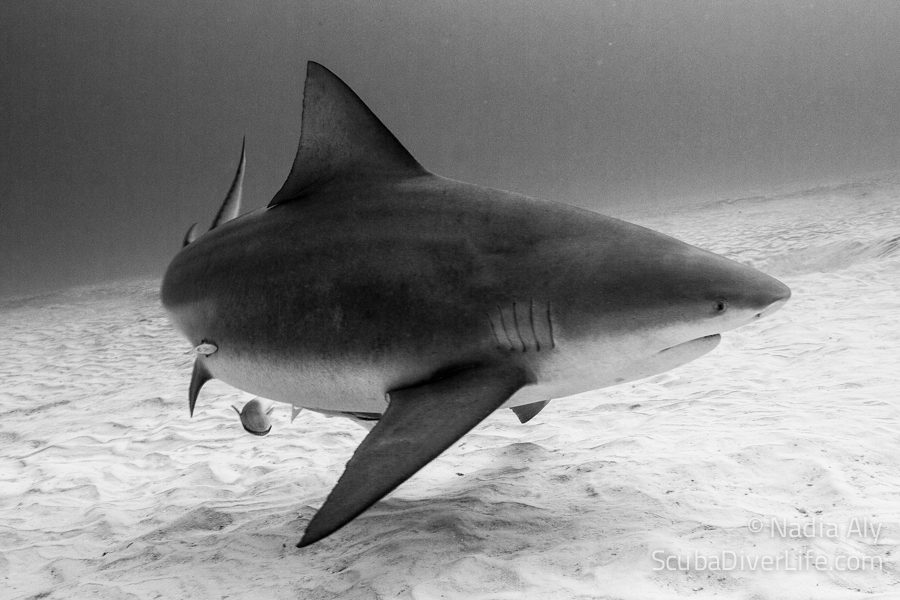Bull shark dives in Playa del Carmen have evolved into a quite a popular activity. These sharks are magnificent creatures; they can grow to be bigger than any scuba diver; and they are graceful and powerful. Whenever you get to see them on the reef, other fish seem to be a little bit more careful. Divers have seen bull sharks on Playa reefs for over 30 years. Los Arcos, one of the more popular deep dive sites north of Playa, used to be known as Sharkies Place, named after the common shark sightings, rather than its deep swim-throughs.
Say No to Bull Shark Dives in Playa Del Carmen
Over the last three decades, these sightings have become less frequent. Fishing and increased coastal development have put pressure on the reef in general and specifically on big fish, such as jacks, snappers, groupers, barracuda, and particularly sharks. One can still see any or all of those fish on a single dive along the coast of the Riviera Maya but it is less likely now than 20 or 30 years ago. It was more probable to see these big fish on the deep reefs than on the shallow reefs, so if you wanted to see bull sharks you had to go to 180 feet (55 m) or deeper to encounter. Diving to these depths is beyond most recreational divers’ skill level, therefore most tourists visiting Riviera Maya were not able to appreciate the presence of these sharks until certain local dive operators started luring sharks to the shallower water by feeding them on dive tours.
An Upended Ecosystem
For several years now, bull-shark dives have been actively promoted in Playa del Carmen, but there are several concerns related to feeding sharks underwater and attracting them to shallower sites for divers to see. The first concern is altering the feeding pattern of sharks. They are getting used to divers and relying on divers for their food. This could be troublesome to the sharks and ecosystem, but it also creates a risk for the divers safety. It is not unusual for fish that are fed to become aggressive towards divers in the water because they start to associate all divers with food. It is not impossible that a tourist will get mistakenly attacked and seriously hurt by a shark; these incidents have happened in the Bahamas. In my opinion it is naive to think that this will not happen in Playa del Carmen if dive operators continue to feed sharks.
Unsafe for Sharks
There is another, more pressing concern regarding shark feeding and sharks congregating on the same dive site weeks in a row. Most tourists probably don’t know that sharks are not actively protected in Mexico. Fishermen can kill sharks without any problem, and have been killing the same sharks divers feed and try to lure into the shallows. In the past, bull sharks, like all other sharks, were fished as well. But because these fish were more secretive and would never congregate at the same site it would be unlikely for one fisherman to kill five, six or seven sharks on one day. There are several disturbing videos and photos rotating on the internet of Mexican fishermen showing off their catch of the day.
Every time sharks are killed there is outrage among all dive operators and divers in Playa del Carmen. However, the fishermen argue that they have permits to fish sharks and fishing is their job. Inevitably, emotions get quite high, but no solution exists as of today. Local government does not seem in the position to offer a solution and the same process of luring sharks out of the deep by divers starts again. The divers try to keep it secret from the fishermen, but they find out and will kill the sharks again. Even though local operators do not actively kill sharks, by feeding sharks and selling bull-shark dives while not ensuring the safety of these animals, Playa del Carmen operators have responsibility in the killing of bull sharks.
The purpose of this article is twofold. First of all, I would like to appeal to all parties involved to come up with a solution. The Mexican government, local fishermen and dive operators need to come up with a long-term scenario where the health of the reef and its inhabitants are guaranteed. There must be a way for fishermen and divers to live together. A no-fish zone shallower than 100 feet (30 m) or no-fish zones and fish zones at certain points along the coast seem to me like simple solutions. I am sure there are marine biologists that can suggest a way for our reef to sustain healthy coral and fish life where both divers and fishermen can pursue their jobs and hobbies.
The other purpose of this article is to inform the general dive public that if you sign up today for bull-shark dives, you are contributing to the certain death of these magnificent creatures, and I don’t think that any diver willingly wants to be a part of this shark horror story. As a scuba diver, you never know what you will see. It is better to visit the reef, blow some bubbles, and appreciate the corals and tropical fish. You may get to see something bigger — a turtle, a manta, or even a bull shark. But if you just say no to baited bull shark dives in Playa del Carmen, you’ll help this magnificent species stick around.
By guest author Nils Van Der Haar from Dive Aventuras Mexico


